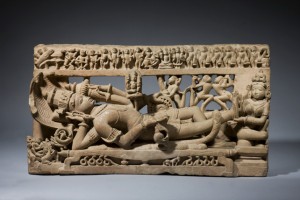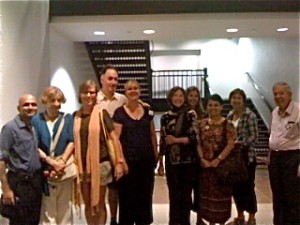The day was cloudy and overcast on Saturday, September 10th, but it became a glorious and special day when a dozen or so Rubin Museum guides joined Ashley Mask at the Brooklyn Museum’s exhibition on Hindu sculptures, paintings and textiles. All the works (with more than 170 exceptional objects) explored the legends of Vishnu. The show titled “Vishnu: Hinduism’s Blue-Skinned Savior” was fully examined with the help of a terrific, knowledgeable, and experienced guide named Lynn who highlighted many pieces within our hour-long tour. She was chock full of information as well as humor. Her attention to detail brought many of the pieces to life. The works came from India, Pakistan, and Bangladesh and were created between the fourth and the twentieth century. Our guide highlighted a 12th century Sandstone sculpture “Vishnu in His Cosmic Sleep” (this was similar to a piece that had been on the walls of the Rubin Museum for its show “Visions of the Cosmos” {December 2010-May 2011} tiled “Vishnu Sleeping on the Cosmic Ocean” 11th century sandstone sculpture). Happily, in both pieces, Vishnu is awakened from his “long sleep” in time for the creator god, Brahma, to emerge and re-create the world.

Vishnu in His Cosmic Sleep. Central India (Madhya Pradesh), circa 12th century. Sandstone, 14 9/16 x 27 9/16 in. (37 x 70 cm). Private collection, Europe. Photo: Courtesy of Oliver Forge and Brendan Lynch Ltd.
In the excellent catalogue from the Frist Center for the Visual Arts, in Tennessee (where the Vishnu show originated), Vishnu’s cosmic sleep is described by a quote from the epic Mahabharata. It’s moving poetry: “When there was but a single, dreadful ocean, and the moving and standing creation had perished, and all the creatures had come to an end…the blessed Vishnu, the everlasting source of all creatures, the eternal Person, slept solitarily on his ocean bed in the vast coil of the boundlessly puissant snake Shesha…While the God was sleeping, a lotus of the luster of the sun sprouted from his navel; and there, in that sun-like and moon-like lotus, Grandfather himself was born, Brahma, the guru of the world.”
In the catalogue, Joan Cummins, Ph.D, who was also the show’s original curator, further illuminates the experience of viewing this amazing work of art. She writes:
“….Vishnu lies on Shesha for his cosmic sleep; the fact that Creation takes place while Vishnu is asleep suggests that everything we experience is merely Vishnu’s dream. In Indian traditions, the navel is often cited as a locus of power, and a god’s navel is said to be the central point around which the universe revolves. Lotuses are usually emblems of transcendence, rising up from the murk to bloom in pure colors; here the lotus stalk is more like an umbilical cord, albeit attached to the source’s stomach rather than to the offspring’s.” I couldn’t get that image out of my mind.
Our guide also highlighted “The Battle Between the Forces of Rama and Ravana” a complex “giant melee” watercolor painted in Eastern India, Western Bengal (probably Kolkata) c. 1860, which we were told had been painted by an artist who seemed to have knowledge of “western pictorial conventions, including the use of atmospheric perspective; the use of lighter colors and blurrier outlines on the smaller figures toward the horizon enhances the sense that they are further away than the more vividly rendered figures in the foreground.” The fanciful detail of the victorious monkey gods added to my enjoyment of this spectacular painting. This story comes from the epic Sanskrit story by Valmiki written between the seventh and fourth centuries BCE titled “Ramayana.” The Hindu mythology is wide and deep and seeing this show made me fall in love with Vishnu.
Do take the opportunity to go and see this amazing show before it closes on Sunday, October 2nd, 2011. (Sadly it will not travel to another venue).
—— Annette Wallach Cohen, Rubin Museum Docent



